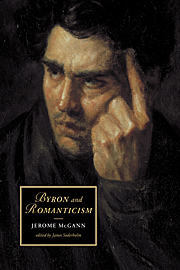Book contents
- Frontmatter
- Contents
- Acknowledgments
- General analytical and historical introduction
- PART I
- PART II
- 10 A point of reference
- 11 History, herstory, theirstory, ourstory
- 12 Literature, meaning, and the discontinuity of fact
- 13 Rethinking Romanticism
- 14 An interview with Jerome McGann
- 15 Poetry, 1780–1832
- 16 Byron and Romanticism, a dialogue (Jerome McGann and the editor, James Soderholm)
- Subject index
- Authors index
- CAMBRIDGE STUDIES IN ROMANTICISM
13 - Rethinking Romanticism
Published online by Cambridge University Press: 22 September 2009
- Frontmatter
- Contents
- Acknowledgments
- General analytical and historical introduction
- PART I
- PART II
- 10 A point of reference
- 11 History, herstory, theirstory, ourstory
- 12 Literature, meaning, and the discontinuity of fact
- 13 Rethinking Romanticism
- 14 An interview with Jerome McGann
- 15 Poetry, 1780–1832
- 16 Byron and Romanticism, a dialogue (Jerome McGann and the editor, James Soderholm)
- Subject index
- Authors index
- CAMBRIDGE STUDIES IN ROMANTICISM
Summary
Until the early 1980s scholars of Romanticism generally accepted Rene Wellek's classic modern definition of their subject: “Imagination for the view of poetry, nature for the view of the world, and symbol and myth for poetic style.” This formulation represents, on one hand, a synthesis of an originary Romantic tradition of thought, and, on the other, the bounding horizon for much of the work on Romanticism done until fairly recently.
Today that synthesis has collapsed and debate about theory of Romanticism is vigorous – from cultural studies, feminist scholarship, even from various types of revived philological investigations. My own work has been much engaged with these revaluations, not least since the publication of The Romantic Ideology in 1983. Because these discussions have (inevitably) influenced my own thinking about Romanticism, as well as the more general problem of periodization, I want to return to the subject once again.
Between 1978 and 1983, when I first addressed these issues, I was not concerned with the question of periodization as such. I was more interested in the conceptual representations of Romanticism – contemporary representations as well as subsequent scholarly representations. The periodization issue entered my purview obliquely – for example, in relation to the kinds of problems that arise when a clear distinction is not maintained between certain cultural formations (like Romanticism, modernism, or post-Modernism) and the historical frameworks within which they develop and mutate.
- Type
- Chapter
- Information
- Byron and Romanticism , pp. 236 - 255Publisher: Cambridge University PressPrint publication year: 2002

